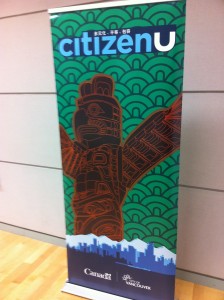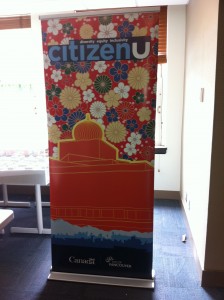 Over the past five weeks, my placement at Kitsilano Neighbourhood House has primarily focused on assisting staff in organizing and facilitating the citizenU program. This program is an Action Research Initiative supported by the City of Vancouver that aims to educate youth between the ages of fifteen and twenty on discrimination, racism and bullying in their schools and neighbourhoods. In essence, it endeavours to raise awareness about inclusivity among young residents and citizens, and intends to debunk undesirable stereotypes.
Over the past five weeks, my placement at Kitsilano Neighbourhood House has primarily focused on assisting staff in organizing and facilitating the citizenU program. This program is an Action Research Initiative supported by the City of Vancouver that aims to educate youth between the ages of fifteen and twenty on discrimination, racism and bullying in their schools and neighbourhoods. In essence, it endeavours to raise awareness about inclusivity among young residents and citizens, and intends to debunk undesirable stereotypes.
citizenU, is a form of citizenship education that promotes knowledge and awareness of multiculturalism and inclusivity. Katharyne Mitchell, in her essay, entitled, “Education for Democratic Citizenship: Transnationalism, Multiculturalism, and the Limits of Liberalism”, explains that much modern democratic thought behind educational theory in Canada encompasses the idea that education must be culturally pluralistic and collective in nature. Education must therefore incorporate multiculturalism as a national narrative in order to promote a democratic public sphere. citizenU, in its content and structure, can be said to represent this type of education as it provides a platform for youth of all backgrounds to explore themes of diversity, equality and inclusivity within a public arena.
The basis of my final project stems specifically from my observations of participant interactions during citizenU training sessions at Kits House. In an increasingly multicultural city, it seems that citizenship education is a necessity among resident and citizen youth. The neighbourhood house setting is an ideal environment for promoting this type of education among the youth that access its services. I view the neighbourhood house as a space where youth from diverse backgrounds and belief systems can join together to discuss concepts and realities that they might otherwise not approach on their own.
 Although merely an office area (given the organization’s recent temporary relocation), Kits House seems to provide a space for fostering awareness and encouraging solidarity among its diverse participant base. I have only been able to observe participants interact and engage in citizenU activities on a few occasions, however these observations have allowed me to make connections with themes from Sean Lauer and Miu Chung Yan‘s paper, Neighbourhood Houses and Bridging Social Ties. The authors explain that neighbourhood houses, or “voluntary associations”, as they are referred to, play a role in drawing people (both local and immigrant) together to form strong social ties as well as diverse peer networks. They also mention that such organizations allow for involvement throughout “the lifecourse” that other institutions or facilities, such as schools, may not be able to offer. This certainly is true of the citizenU program at Kits House. By providing a common space for learning about discrimination, diversity and inclusivity, through creative games and activities, Kits House offers a form of citizenship education that many schools do not or cannot. This neighbourhood house strives to meet the “instrumental and expressive needs” (as articulated by Lauer and Yan) of its youth participants. In essence, by teaching and promoting citizenship education, Kits House has given youth across ages (that is, between 13 and 19 years of age) the opportunity to collaborate intellectually, cultivate friendships and communicate ideas that they might not otherwise have found the space in which to do so.
Although merely an office area (given the organization’s recent temporary relocation), Kits House seems to provide a space for fostering awareness and encouraging solidarity among its diverse participant base. I have only been able to observe participants interact and engage in citizenU activities on a few occasions, however these observations have allowed me to make connections with themes from Sean Lauer and Miu Chung Yan‘s paper, Neighbourhood Houses and Bridging Social Ties. The authors explain that neighbourhood houses, or “voluntary associations”, as they are referred to, play a role in drawing people (both local and immigrant) together to form strong social ties as well as diverse peer networks. They also mention that such organizations allow for involvement throughout “the lifecourse” that other institutions or facilities, such as schools, may not be able to offer. This certainly is true of the citizenU program at Kits House. By providing a common space for learning about discrimination, diversity and inclusivity, through creative games and activities, Kits House offers a form of citizenship education that many schools do not or cannot. This neighbourhood house strives to meet the “instrumental and expressive needs” (as articulated by Lauer and Yan) of its youth participants. In essence, by teaching and promoting citizenship education, Kits House has given youth across ages (that is, between 13 and 19 years of age) the opportunity to collaborate intellectually, cultivate friendships and communicate ideas that they might not otherwise have found the space in which to do so.
Works Cited:
Lauer. S.R. & Yan, M.C.
2007. Neighbourhood Houses and Social Ties. Centre of Excellence for Research on Immigration and Diversity: Working Paper Series. 5-34.
Mitchell, K.
2001. Education for Democratic Citizenship: Transnationalism, Multiculturalism, and the Limits of Liberalism. Harvard Educational Review 71(1): 51-78
